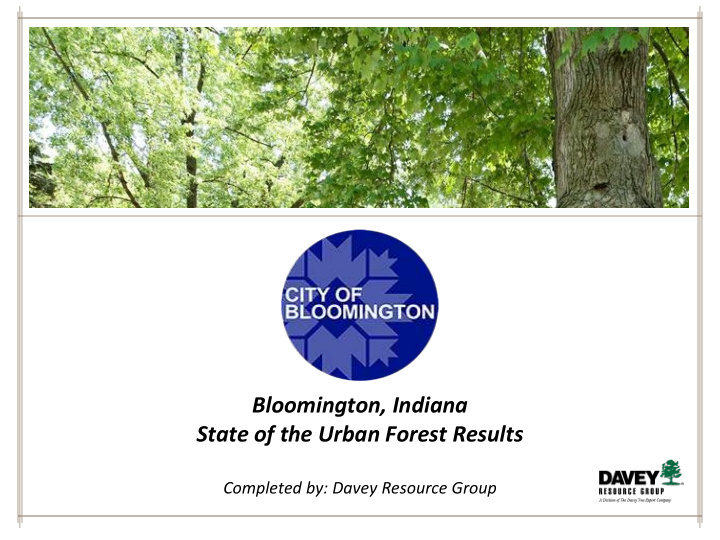



Bloomington, Indiana State of the Urban Forest Results Completed by: Davey Resource Group
What is an Urban Forest? Why measure an Urban Forest? You can’t manage what you can’t measure Prioritize and schedule work. Budget predictions. Understand and plan for threats. Develop or measure progress towards goals. Report accomplishments. Communication and outreach.
A tree inventory provides information about individual trees; collectively the data can provide information about the benefit-services and reliance of the tree population.
An urban tree canopy assessment provides information about public and private trees; collectively the data can provide information about the benefit-services and equity of the natural resource.
Sites included in the inventory : • Trees, stumps, and vacant planting sites • Located within the 237 miles of city maintained street ROW and 11 city parks • Planting sites were identified as small, medium and large Data fields: Location (Address) Primary Maintenance Need GIS X and Y Defects Species Risk Rating Diameter at Breast Height (DBH) Further Inspect Multi-Stem Overhead Utilities Tree Condition Tree Grate Data collection: February to August 2019
Types of Sites 24,371 Total sites ○ 19,013 Trees ○ 4,417 Plantings sites ○ 741 Stumps ○ Stocking Level 77% 1994 Inventory 10,522 Street Trees 2019 Inventory 17,541 Street Trees Differences Trees 7,019 Stocking Level -14%
Species and Genus Diversity 14% 13% 11% 12% 11% 10% 10% 8% 8% 7% 6% 6% 6% 6% 4% 3% 3% 2% 1% 0% red maple callery pear northern sugar silver flowering red oak maple maple crabapple 2019 1994 Ideal 168 species representing 63 genera 2019 maple represents 24% 1994 maple represented 30%
100% Tree Condition 90% 80% • Healthy population of Fair and 70% Good condition trees make up Percent of Trees 92% of all trees 60% • 50% Poor and Dead make up 8% 40% 30% 20% 1994 Inventory 10% Healthy population 87% 0% Number of Trees Difference Good 8,022 Healthier by 13% Fair 9,522 Poor 1,170 Dead 299
Diameter Class Distribution 70% 60% 49% 50% Percent of Population 40% 35% 30% 20% 10% 6% 10% 0% 0–8" 9–17" 18–24" > 24" (Young) (Established) (Maturing) (Mature) 2019 Ideal 1994 Expon. (1994) Size Class (inches)
Maintenance Needs Removal 1,302 Prune 2,881 Discretionary Prune 8,833 Training Prune 5,997 Large-growing Planting 1,428 Medium-growing Planting 454 Small-growing Planting 2,735 0 5,000 10,000 NUMBER OF TREES
City-Managed Public Tree Benefits Aesthetic Air Quality Carbon Sequestered and Avoided Energy Stormwater Total Annual Benefit $968,823 Benefit per capita $11 Benefit per tree $51
TreeKeeper Software Bloomington uses Davey’s TreeKeeper software; data was delivered in TreeKeeper, ESRI, and Excel.
Land cover included in the urban tree canopy assessment : • Tree canopy, impervious surface, pervious surface, bare soil, and open water • 15,000 acres citywide • Plantable spaces were identified and ranked by priority Results: Tree canopy 5,735 acres Impervious surface 5,064 acres Pervious surface 3,641 acres Bare soil 435 acres Open water 125 acres Data collection: 2018 National Agricultural Imagery Program (NAIP) leaf-on, multispectral imagery acquired and processed by the United States Department of Agriculture (USDA)
Land Cover and Prioritized Plantable Space
Maximum Tree Canopy 3,338 Plantable acres 61% ○ 176 acres Very high ○ 356 acres High ○ 417 acres Moderate ○ 455 acres Low ○ 1,934 acres Very low Environmental Factors
Tree Canopy Change over 50 years 42% 40% 39% 40% 38% 38% 37% 38% 37% 37% 36% 35% 33% 34% 32% 30% 1998 2008 2018 2028 2038 2048 City of Bloomington Tree Canopy Change City of Bloomington Tree Canopy Projected Change over 10 Years (1.6%) City of Bloomington Tree Canopy Projected Change over 20 Years (0.6%)
Tree Canopy Change 1998 2016
100% Canopy Condition 90% 80% Percent of Acres 70% • Healthy population of Fair and 60% Good condition trees make up 50% 74% of all trees 40% • Poor and Dead make up 24% 30% 20% 10% 0% Number of Acres Very Good 423 Good 1,840 Fair 2,007 Poor 1,081 Dead/Dying 295 Shadow/Not 90 Classified
Other Analyses • Geographic units: census tracts, city-owned parcels, citywide, council districts, Indiana University campus, neighborhood associations, parks, watersheds, and zoning. Neighborhoods with most tree canopy percentage: Bittner Woods, South Griffy, and Woodlands-Winding Brook Neighborhoods with most tree canopy acreage: Elm Heights, Covenanter, Sherwoods Oaks Neighborhoods with most positive change in tree canopy percentage: Autumn View, Southern Pines, Highland Village • Urban Tree Resource Analysis and Cost Estimator (UTRACE) tool, utilizes the land cover assessment data to estimate the number of trees required and costs to increase and maintain the newly planted tree canopy. 2% CANOPY INCREASE = 10,841 TREES for COST OF $4,770,016 Zoning Types with most trees to be planted: Institutional, Planned Unit Development, and Residential Core
Other Analyses - Socio-Demographic and Economic Analyses
Urban Tree Canopy Benefits Carbon Sequestered Stormwater Air Quality Total Benefit $54,994,625 Total Annual Benefit $1,931,950 Aesthetic and Other Benefits $19,688,555 Stored Carbon Benefit $33,374,120
TreeKeeper Software Bloomington’s prioritized planting plan is on TreeKeeper; assessment deliverables in ESRI with projection and metadata and supporting analyses are in Excel with few Maps in jpeg and PDF formats.
Bloomington Storymap
Summary and Next Steps • Create a 5 to 7 year public tree management plan to develop a strategies for improving genus and species diversity, manage for maturing/mature tree population, and maximize public benefit through planting and building resiliency. • Prune young trees now to improve structure encouraging better from as they age. Theoretically, this is a cost saver down the road. • Use TreeKeeper to keep the inventory up-to-date as work is performed, budget for partial re-inventory every year to continually measure progress and adjust, and tree preservation and landscape plans. • Review and revise as necessary the tree ordinance, adjust tree preservation and landscape ordinance, and refine other policies. • Consider tree canopy goal establishment and an urban forest master plan to bring the community together in achieving the same goal and building equity.
Thank you for working with Davey Resource Group! QUESTIONS? Aren Flint, Senior Associate Consultant Aren.Flint@Davey.com 765-430-9020
Recommend
More recommend